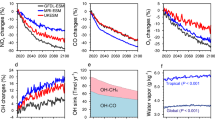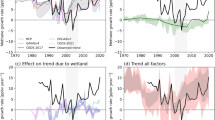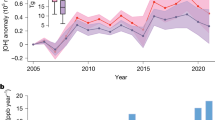Abstract
Methane is an important greenhouse gas1 and its atmospheric concentration has almost tripled since pre-industrial times2,3,4. Atmospheric methane mixing ratios vary seasonally, with the seasonal cycle amplitude (SCA) having decreased in northern high latitudes and increased in the subtropics and tropics since the 1980s5,6. These opposing SCA trends can help understanding of long-term changes in the global methane budget, as methane emissions and sinks have opposing effects on the SCA5. However, trends in the methane SCA have not yet been explored in detail5,6. Here we use a suite of atmospheric transport model simulations and attribute the observed trends in the seasonal amplitude of methane to changes in emissions and the atmospheric sink from reaction with the hydroxyl radical (OH). We find that the decreasing amplitude in the northern high latitudes is mainly caused by an increase in natural emissions (such as wetlands) owing to a warmer climate, adding evidence to previous studies suggesting a positive climate feedback7,8,9. In contrast, the enhanced methane amplitude in the subtropics and tropics is mainly attributed to strengthened OH oxidation. Our results provide independent evidence for an increase in tropospheric OH concentration10,11 of 10 ± 1% since 1984, which together with an increasing atmospheric methane concentration suggests a 21 ± 1% increase in the atmospheric methane sink.
This is a preview of subscription content, access via your institution
Access options
Access Nature and 54 other Nature Portfolio journals
Get Nature+, our best-value online-access subscription
27,99 € / 30 days
cancel any time
Subscribe to this journal
Receive 51 print issues and online access
199,00 € per year
only 3,90 € per issue
Buy this article
- Purchase on SpringerLink
- Instant access to full article PDF
Prices may be subject to local taxes which are calculated during checkout



Similar content being viewed by others
Data availability
All observation and model data that support the findings of this study are available as follows. The site-level atmospheric CH4 concentration data are obtained from https://gml.noaa.gov/ccgg/trends_ch4/. The aircraft data of CH4 concentration are obtained from https://gml.noaa.gov/aftp/data/trace_gases/ch4/pfp/aircraft/. The EDGAR v7.0 data are downloaded from https://edgar.jrc.ec.europa.eu/dataset_ghg70. The CEDS 2021 data are downloaded from https://data.pnnl.gov/dataset/CEDS-4-21-21. The BB4CMIP data are downloaded from https://esgf-node.llnl.gov/projects/input4mips/. The GFED v4.1s data are obtained from https://www.geo.vu.nl/~gwerf/GFED/GFED4/. The wetland emissions from ORCHIDEE are available from ref. 7. The CAMS wetland emissions data are downloaded from https://www.ecmwf.int/en/forecasts/dataset/cams-greenhouse-gas-ghg-flux-inversions. The LPJ-EOSIM wetland emissions data are downloaded from https://doi.org/10.5067/Community/LPJ-EOSIM/LPJ_EOSIM_L2_MCH4E.001. The LMDZ-INCA OH concentration data are available from ref. 7. The OH fields simulated by Earth system models are downloaded from https://esgf-data.dkrz.de/search/cmip6-dkrz/. The MERRA-2 hourly climate forcing data are obtained from https://gmao.gsfc.nasa.gov/reanalysis/MERRA-2. The monthly temperature and precipitation from CRU TS v4.05 are downloaded from https://crudata.uea.ac.uk/cru/data/hrg/cru_ts_4.05. The MSWEP monthly precipitation data are downloaded from http://www.gloh2o.org/mswep. The monthly temperature, precipitation and soil temperature from ERA5 reanalysis data are downloaded from https://www.ecmwf.int/en/forecasts/dataset/ecmwf-reanalysis-v5. The GLEAM v3.8a monthly root-zone soil moisture data are downloaded from https://www.gleam.eu. The GEOS-Chem simulated surface and tropospheric CH4 concentrations and OH concentrations are publicly available at https://doi.org/10.6084/m9.figshare.28425077. Details are shown in Supplementary Table 2. Source data are provided with this paper.
Code availability
The community-led GEOS-Chem model of atmospheric chemistry and transport is maintained centrally by Harvard University (https://geoschem.github.io/) and is open access at https://github.com/geoschem/geos-chem. Code and documentation for ORCHIDEE (MICT v8.4.4) is publicly available at http://forge.ipsl.jussieu.fr/orchidee.
References
IPCC Climate Change 2013: The Physical Science Basis (eds Stocker, T. F. et al.) (Cambridge Univ. Press, 2013).
Rubino, M. et al. Revised records of atmospheric trace gases CO2, CH4, N2O, and δ13C-CO2 over the last 2000 years from Law Dome, Antarctica. Earth Syst. Sci. Data 11, 473–492 (2019).
Mitchell, L., Brook, E., Lee, J. E., Buizert, C. & Sowers, T. Constraints on the late Holocene anthropogenic contribution to the atmospheric methane budget. Science 342, 964–966 (2013).
Dlugokencky, E. J., Nisbet, E. G., Fisher, R. & Lowry, D. Global atmospheric methane: budget, changes and dangers. Phil. Trans. R. Soc. A 369, 2058–2072 (2011).
Dlugokencky, E. J., Masarie, K. A., Tans, P. P., Conway, T. J. & Xiong, X. Is the amplitude of the methane seasonal cycle changing? Atmos. Environ. 31, 21–26 (1997).
Dowd, E. et al. Decreasing seasonal cycle amplitude of methane in the northern high latitudes being driven by lower-latitude changes in emissions and transport. Atmos. Chem. Phys. 23, 7363–7382 (2023).
Peng, S. et al. Wetland emission and atmospheric sink changes explain methane growth in 2020. Nature 612, 477–482 (2022).
Zhang, Z. et al. Recent intensification of wetland methane feedback. Nat. Clim. Change 13, 430–433 (2023).
Yuan, K. et al. Boreal–Arctic wetland methane emissions modulated by warming and vegetation activity. Nat. Clim. Change 14, 282–288 (2024).
Naus, S. et al. Constraints and biases in a tropospheric two-box model of OH. Atmos. Chem. Phys. 19, 407–424 (2019).
Skeie, R. B., Hodnebrog, Ø. & Myhre, G. Trends in atmospheric methane concentrations since 1990 were driven and modified by anthropogenic emissions. Commun. Earth Environ. 4, 317 (2023).
Lan, X., Thoning, K. W. & Dlugokencky, E. J. Trends in globally-averaged CH4, N2O, and SF6 determined from NOAA Global Monitoring Laboratory measurements. Version 2024-06. NOAA Global Monitoring Laboratory https://doi.org/10.15138/P8XG-AA10 (2024).
Dlugokencky, E. J. et al. Atmospheric methane levels off: temporary pause or a new steady-state? Geophys. Res. Lett. 30, 1992 (2003).
Nisbet, E. G. et al. Very strong atmospheric methane growth in the 4 years 2014–2017: implications for the Paris Agreement. Glob. Biogeochem. Cycles 33, 318–342 (2019).
Saunois, M. et al. The global methane budget 2000–2017. Earth Syst. Sci. Data 12, 1561–1623 (2020).
Lan, X. et al. Improved constraints on global methane emissions and sinks using δ13C-CH4. Glob. Biogeochem. Cycles 35, e2021GB007000 (2021).
Schaefer, H. et al. A 21st-century shift from fossil-fuel to biogenic methane emissions indicated by 13CH4. Science 352, 80–84 (2016).
Turner, A. J., Frankenberg, C., Wennberg, P. O. & Jacob, D. J. Ambiguity in the causes for decadal trends in atmospheric methane and hydroxyl. Proc. Natl Acad. Sci. USA 114, 5367–5372 (2017).
Basu, S. et al. Estimating emissions of methane consistent with atmospheric measurements of methane and δ13C of methane. Atmos. Chem. Phys. 22, 15351–15377 (2022).
Keeling, C. D., Chin, J. F. S. & Whorf, T. P. Increased activity of northern vegetation inferred from atmospheric CO2 measurements. Nature 382, 146–149 (1996).
Graven, H. D. et al. Enhanced seasonal exchange of CO2 by northern ecosystems since 1960. Science 341, 1085–1089 (2013).
Zeng, N. et al. Agricultural Green Revolution as a driver of increasing atmospheric CO2 seasonal amplitude. Nature 515, 394–397 (2014).
Forkel, M. et al. Enhanced seasonal CO2 exchange caused by amplified plant productivity in northern ecosystems. Science 351, 696–699 (2016).
Thoning, K. W., Tans, P. P. & Komhyr, W. D. Atmospheric carbon dioxide at Mauna Loa Observatory: 2. Analysis of the NOAA GMCC data, 1974–1985. J. Geophys. Res. Atmos. 94, 8549–8565 (1989).
McKain, K. et al. NOAA Global Greenhouse Gas Reference Network Flask-Air PFP Sample Measurements of CO2, CH4, CO, N2O, H2, SF6 and isotopic ratios collected from aircraft vertical profiles [Data set]. Version: 2023-08-11. NOAA Global Monitoring Laboratory https://doi.org/10.15138/39HR-9N34 (2023).
Rantanen, M. et al. The Arctic has warmed nearly four times faster than the globe since 1979. Commun. Earth Environ. 3, 168 (2022).
Bintanja, R. et al. Strong future increases in Arctic precipitation variability linked to poleward moisture transport. Sci. Adv. 6, eaax6869 (2020).
Lin, X. et al. Recent methane surges reveal heightened emissions from tropical inundated areas. Nat. Commun. 15, 10894 (2024).
Koffi, E. N., Bergamaschi, P., Alkama, R. & Cescatti, A. An observation-constrained assessment of the climate sensitivity and future trajectories of wetland methane emissions. Sci. Adv. 6, eaay4444 (2020).
Descals, A. et al. Unprecedented fire activity above the Arctic Circle linked to rising temperatures. Science 378, 532–537 (2022).
Zheng, B. et al. Record-high CO2 emissions from boreal fires in 2021. Science 379, 912–917 (2023).
Shen, L. et al. National quantifications of methane emissions from fuel exploitation using high resolution inversions of satellite observations. Nat. Commun. 14, 4948 (2023).
van Marle, M. J. E. et al. Historic global biomass burning emissions for CMIP6 (BB4CMIP) based on merging satellite observations with proxies and fire models (1750–2015). Geosci. Model Dev. 10, 3329–3357 (2017).
Segers, A., Steinke, T. & Houweling, S. Description of the CH4 Inversion Production Chain, CAMS (Copernicus Atmospheric Monitoring Service) Report (2022); https://atmosphere.copernicus.eu/sites/default/files/2022-10/CAMS255_2021SC1_D55.5.2.1-2021CH4_202206_production_chain_CH4_v1.pdf.
Xi, Y., Peng, S., Ciais, P. & Chen, Y. Future impacts of climate change on inland Ramsar wetlands. Nat. Clim. Change 11, 45–51 (2021).
Xi, Y. et al. Gridded maps of wetlands dynamics over mid-low latitudes for 1980–2020 based on TOPMODEL. Sci. Data 9, 347 (2022).
Bernard, J. et al. Assessing the time variability of GIEMS-2 satellite-derived surface water extent over 30 years. Front. Remote Sens. https://doi.org/10.3389/frsen.2024.1399234 (2024).
Zhang, X. et al. Global annual wetland dataset at 30 m with a fine classification system from 2000 to 2022. Sci. Data 11, 310 (2024).
Collins, W. J. et al. AerChemMIP: quantifying the effects of chemistry and aerosols in CMIP6. Geosci. Model Dev. 10, 585–607 (2017).
Zhao, Y. et al. On the role of trend and variability in the hydroxyl radical (OH) in the global methane budget. Atmos. Chem. Phys. 20, 13011–13022 (2020).
Stevenson, D. S. et al. Trends in global tropospheric hydroxyl radical and methane lifetime since 1850 from AerChemMIP. Atmos. Chem. Phys. 20, 12905–12920 (2020).
IPCC Climate Change 2021: The Physical Science Basis (eds Masson-Delmotte, V. et al.) (Cambridge Univ. Press, 2021).
Wang, Y. & Jacob, D. J. Anthropogenic forcing on tropospheric ozone and OH since preindustrial times. J. Geophys. Res. Atmos. 103, 31123–31135 (1998).
McDuffie, E. E. et al. A global anthropogenic emission inventory of atmospheric pollutants from sector- and fuel-specific sources (1970–2017): an application of the Community Emissions Data System (CEDS). Earth Syst. Sci. Data 12, 3413–3442 (2020).
Claxton, T. et al. A synthesis inversion to constrain global emissions of two very short lived chlorocarbons: dichloromethane, and perchloroethylene. J. Geophys. Res. Atmos. 125, e2019JD031818 (2020).
East, J. D. et al. Interpreting the seasonality of atmospheric methane. Geophys. Res. Lett. 51, e2024GL108494 (2024).
Vautard, R., Yiou, P. & Ghil, M. Singular-spectrum analysis: a toolkit for short, noisy chaotic signals. Physica D 58, 95–126 (1992).
Dlugokencky, E. J., Steele, L. P., Lang, P. M. & Masarie, K. A. The growth rate and distribution of atmospheric methane. J. Geophys. Res. Atmos. 99, 17021–17043 (1994).
Stekhoven, D. J. & Bühlmann, P. MissForest—non-parametric missing value imputation for mixed-type data. Bioinformatics 28, 112–118 (2012).
Crippa, M. et al. GHG Emissions of All World Countries: 2021 Report (Publications Office of the European Union, 2021); https://doi.org/10.2760/173513.
O’Rourke, P. et al. CEDS v_2021_02_05 release emission data. Zenodo https://doi.org/10.5281/zenodo.4509372 (2021).
Guimberteau, M. et al. ORCHIDEE-MICT (v8.4.1), a land surface model for the high latitudes: model description and validation. Geosci. Model Dev. 11, 121–163 (2018).
van der Werf, G. R. et al. Global fire emissions estimates during 1997–2016. Earth Syst. Sci. Data 9, 697–720 (2017).
Hauglustaine, D. A. et al. Interactive chemistry in the Laboratoire de Météorologie Dynamique general circulation model: description and background tropospheric chemistry evaluation. J. Geophys. Res. Atmos. 109, D04314 (2004).
Hauglustaine, D. A., Balkanski, Y. & Schulz, M. A global model simulation of present and future nitrate aerosols and their direct radiative forcing of climate. Atmos. Chem. Phys. 14, 11031–11063 (2014).
Shen, L. et al. A machine-learning-guided adaptive algorithm to reduce the computational cost of integrating kinetics in global atmospheric chemistry models: application to GEOS-Chem versions 12.0.0 and 12.9.1. Geosci. Model Dev. 15, 1677–1687 (2022).
China Statistical Yearbook 2021 (China Statistics Press, 2021).
Global Modeling and Assimilation Office (GMAO). MERRA-2 tavg1_2 d_flx_Nx: 2d,1-hourly, time-averaged, single-level, assimilation, surface flux diagnostics V5.12.4. GSFC DAAC https://doi.org/10.5067/7MCPBJ41Y0K6 (2021).
Beck, H. E. et al. MSWEP: 3-hourly 0.25° global gridded precipitation (1979–2015) by merging gauge, satellite, and reanalysis data. Hydrol. Earth Syst. Sci. 21, 589–615 (2017).
Beck, H. E. et al. MSWEP V2 global 3-hourly 0.1° precipitation: methodology and quantitative assessment. Bull. Am. Meteorol. Soc. 100, 473–500 (2019).
Zhang, Z., Zimmermann, N. E., Kaplan, J. O. & Poulter, B. Modeling spatiotemporal dynamics of global wetlands: comprehensive evaluation of a new sub-grid TOPMODEL parameterization and uncertainties. Biogeosciences 13, 1387–1408 (2016).
Colligan, T., Poulter, B. & Colin, Q. LPJ-EOSIM L2 global simulated monthly wetland methane flux V001, distributed by NASA EOSDIS Land Processes Distributed Active Archive Center. Earth Data https://doi.org/10.5067/Community/LPJ-EOSIM/LPJ_EOSIM_L2_MCH4E.001 (2024).
Messina, P. et al. Global biogenic volatile organic compound emissions in the ORCHIDEE and MEGAN models and sensitivity to key parameters. Atmos. Chem. Phys. 16, 14169–14202 (2016).
Acknowledgements
The study was supported by the National Natural Science Foundation of China (42325102), and by the National Key Research and Development Program of China (2022YFE0209100). P.C. and X. Lin acknowledge support from European Space Agency (ESA) project RECCAP2-CS (grant no. 4000144908/24/1-LR). P.C. and Y.X. acknowledge support from the CALIPSO project funded by the generosity of Schmidt Science. We are grateful for the computational resources provided by the High-performance Computing Platform of Peking University supercomputing facility. We thank the scientists from NOAA that acquired and provided CH4 site and aircraft data.
Author information
Authors and Affiliations
Contributions
S.P. conceived of and designed the study. G.L. and S.P. performed the analysis and created all of the figures. S.P. and Y.X. performed the ORCHIDEE simulations. L.S., G.L. and Y.Z. performed the GEOS-Chem simulations. D.H. and X. Lin provided the LMDZ-INCA OH field. X. Lan provided the surface CH4 observations. G.L. and S.P. drafted the paper, with substantial contributions from P.C., L.S. and X. Lan. X. Lin, D.H., A.J.T. and Y.X. contributed to writing and commenting on the draft paper.
Corresponding author
Ethics declarations
Competing interests
The authors declare no competing interests.
Peer review
Peer review information
Nature thanks Hanqin Tian and the other, anonymous, reviewer(s) for their contribution to the peer review of this work.
Additional information
Publisher’s note Springer Nature remains neutral with regard to jurisdictional claims in published maps and institutional affiliations.
Extended data figures and tables
Extended Data Fig. 1 Attribution of changes in seasonal CH4 amplitude between 1984 and 2020 at Barrow, Mauna Loa and South Pole.
Observed and simulated seasonal CH4 amplitude at Barrow (a), Mauna Loa (c) and South Pole (e). The trends of seasonal CH4 amplitude at Barrow (b), Mauna Loa (d) and South Pole (f), and the contributions of emissions (EMI), sink and atmospheric transport (TRA) to the trends of tropospheric seasonal CH4 amplitude. The error bars represent 95% confidence intervals of the estimated trends and the contributions of different factors.
Extended Data Fig. 2 Attribution of the contribution of emission to seasonal amplitude between 1984 and 2020 for six latitudinal bands.
The contributions of fire, anthropogenic, and wetland emissions, and the interaction between atmospheric transport and emissions (IATE; Supplementary Text 4) to the trends of tropospheric average CH4 SCA in six latitudinal bands.
Extended Data Fig. 3 Relationships between wetland surface air temperature and seasonal CH4 amplitude between 1984 and 2020.
The relationship between surface air temperature of high northern wetlands in April, May and June (AMJ) from ERA5 and the observed average seasonal CH4 amplitude derived from 5 northern high latitude ground-based sites (a), the seasonal CH4 amplitude of zonal mean (60°N-90°N) atmospheric CH4 from NOAA observations (b) and the simulated 60°N-90°N tropospheric CH4 SCA (c).
Extended Data Fig. 4 Spatial distribution of the trend in anthropogenic CH4 emissions between 1984 and 2020.
The spatial distribution of the trend in anthropogenic CH4 emissions (a) and the average trend by latitude (b). The mean centre of anthropogenic CH4 emissions in 1985, 1995, 2005 and 2015 is also shown (c).
Extended Data Fig. 5 Attribution of the contribution of sink to seasonal amplitude between 1984 and 2020 for six latitudinal bands.
The contributions of CH4 concentration ([CH4]), OH concentration ([OH]), and the interaction between atmospheric transport and the sink (IATS; Supplementary Text 4) to the trends of tropospheric average CH4 SCA in six latitudinal bands.
Extended Data Fig. 6 Spatial patterns of the trend in OH concentration.
Spatial pattern of trends in OH concentration between 1984–2020 from INCA (a) and GEOS-Chem (b), 1990–2017 from OsloCTM3 (c) and 1984–2014 from the multi-model mean of ESMs (d).
Supplementary information
Supplementary Information
This file contains Supplementary Texts 1–4, Tables 1–3, Figs. 1–33 and References.
Rights and permissions
Springer Nature or its licensor (e.g. a society or other partner) holds exclusive rights to this article under a publishing agreement with the author(s) or other rightsholder(s); author self-archiving of the accepted manuscript version of this article is solely governed by the terms of such publishing agreement and applicable law.
About this article
Cite this article
Liu, G., Shen, L., Ciais, P. et al. Trends in the seasonal amplitude of atmospheric methane. Nature 641, 660–665 (2025). https://doi.org/10.1038/s41586-025-08900-8
Received:
Accepted:
Published:
Issue Date:
DOI: https://doi.org/10.1038/s41586-025-08900-8



